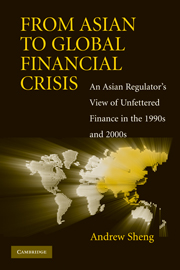 From Asian to Global Financial Crisis
From Asian to Global Financial Crisis Book contents
- Frontmatter
- Contents
- List of Figures
- List of Tables
- Acknowledgements
- Introduction
- 1 Things Fall Apart
- 2 Japan and the Asian Crisis
- 3 The Beam in Our Eyes
- 4 Banking: The Weakest Link
- 5 Washington Consensus and the IMF
- 6 Thailand: The Karma of Globalization
- 7 South Korea: Strong Body, Weak Heart
- 8 Malaysia: The Country That Went Its Own Way
- 9 Indonesia: From Economic to Political Crisis
- 10 Hong Kong: Unusual Times Need Unusual Action
- 11 China: Rise of the Dragon
- 12 From Crisis to Integration
- 13 The New World of Financial Engineering
- 14 What's Wrong with Financial Regulation?
- 15 The Global Financial Meltdown
- 16 A Crisis of Governance
- From Asian to Global Crisis: Chronology of Notable Events
- Abbreviations and Acronyms
- Bibliography
- Index
8 - Malaysia: The Country That Went Its Own Way
Published online by Cambridge University Press: 05 June 2012
- Frontmatter
- Contents
- List of Figures
- List of Tables
- Acknowledgements
- Introduction
- 1 Things Fall Apart
- 2 Japan and the Asian Crisis
- 3 The Beam in Our Eyes
- 4 Banking: The Weakest Link
- 5 Washington Consensus and the IMF
- 6 Thailand: The Karma of Globalization
- 7 South Korea: Strong Body, Weak Heart
- 8 Malaysia: The Country That Went Its Own Way
- 9 Indonesia: From Economic to Political Crisis
- 10 Hong Kong: Unusual Times Need Unusual Action
- 11 China: Rise of the Dragon
- 12 From Crisis to Integration
- 13 The New World of Financial Engineering
- 14 What's Wrong with Financial Regulation?
- 15 The Global Financial Meltdown
- 16 A Crisis of Governance
- From Asian to Global Crisis: Chronology of Notable Events
- Abbreviations and Acronyms
- Bibliography
- Index
Summary
Malaysia Boleh (Malaysia Can Do).
~ National sloganIf you felt that the maelstrom would also catch you, would you contribute US$1 billion to assist Thailand as part of the US$17 billion IMF aid package in August 1997? The fact that Malaysia did so without hesitation was an indication that the Malaysian authorities had little inkling that contagion from the Thai crisis would hit the country so badly and so quickly.
STRONG MACROECONOMIC FUNDAMENTALS
Malaysia is one of the richest countries in Southeast Asia, with a population of 27 million and 330,000 square kilometres in area, roughly the same size as Vietnam with one-third its population and eight times in terms of per capita GDP. Malaysia is rich with oil and gas resources and is one of the world's leading producers of palm oil and natural rubber. Malaysia is also one of the most open economies in the world, with a total trade to GDP of more than 200 percent, whilst foreign banks account for more than 20 percent of banking system assets. Foreign capital had helped build Malaysia into one of the leading exporters of electronic chips and products, accounting for half of exports.
Malaysia successfully overcame the recession of the mid-1980s at the same time as the country was embarking on a voluntary structural adjustment programme that shifted the primary engine of growth from the public to the private sector.
- Type
- Chapter
- Information
- From Asian to Global Financial CrisisAn Asian Regulator's View of Unfettered Finance in the 1990s and 2000s, pp. 187 - 217Publisher: Cambridge University PressPrint publication year: 2009


